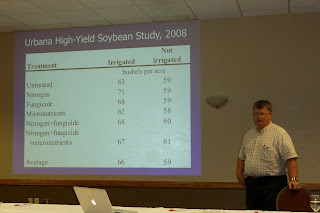I was reading through the Annual Summary for Grain Farms in 2010 from the Kentucky Farm Business Management Program. There is a set of comparisons with the lower 1/3 (LOW 1/3) and the high 1/3 (HI 1/3) in farm returns and return to management.
Farms in the LOW 1/3 tended to spend about $50/A more on all inputs. These broke out to about $20/A more for fertilizer, pesticides and seed, about $14/A more in power and equipment, about $9/A more in labor (biggest portion being unpaid labor) and about $7/A more from insurance and miscellaneous costs.
Farms in the LOW 1/3 also had lower gross farm returns (about $76/A less). Gross farm returns includes livestock, crops, tobacco, custom work, etc. Farms in the LOW 1/3 received about $64/A less in crop returns. Both yields and actual sale price of commodities contribute to this difference.
The M.A.I.N. group has looked mostly at production costs and that allows us to compare efficiencies. However, the group is missing another very large area, which is farm returns. We are reporting yields, but not actual prices for commodities. It would be very interesting to compare the numbers on farm costs (broken out for Crop Costs, Power & Equip., Building, Labor, Other) and look solely at costs per acre. But, I think it would be more useful to the group to compare actual prices received for commodities. That allows us to compare marketing skills. If someone really shines in this area, the rest can learn from it.
Farms in the LOW 1/3 tended to spend about $50/A more on all inputs. These broke out to about $20/A more for fertilizer, pesticides and seed, about $14/A more in power and equipment, about $9/A more in labor (biggest portion being unpaid labor) and about $7/A more from insurance and miscellaneous costs.
Farms in the LOW 1/3 also had lower gross farm returns (about $76/A less). Gross farm returns includes livestock, crops, tobacco, custom work, etc. Farms in the LOW 1/3 received about $64/A less in crop returns. Both yields and actual sale price of commodities contribute to this difference.
The M.A.I.N. group has looked mostly at production costs and that allows us to compare efficiencies. However, the group is missing another very large area, which is farm returns. We are reporting yields, but not actual prices for commodities. It would be very interesting to compare the numbers on farm costs (broken out for Crop Costs, Power & Equip., Building, Labor, Other) and look solely at costs per acre. But, I think it would be more useful to the group to compare actual prices received for commodities. That allows us to compare marketing skills. If someone really shines in this area, the rest can learn from it.





